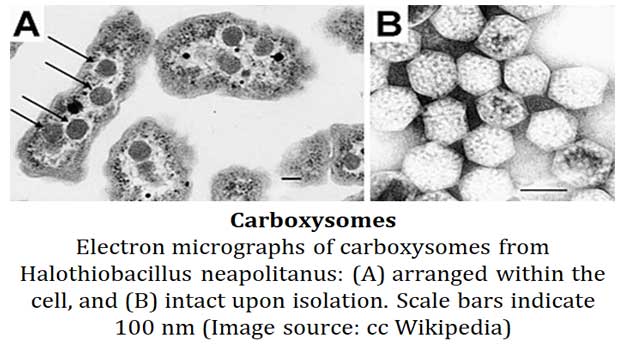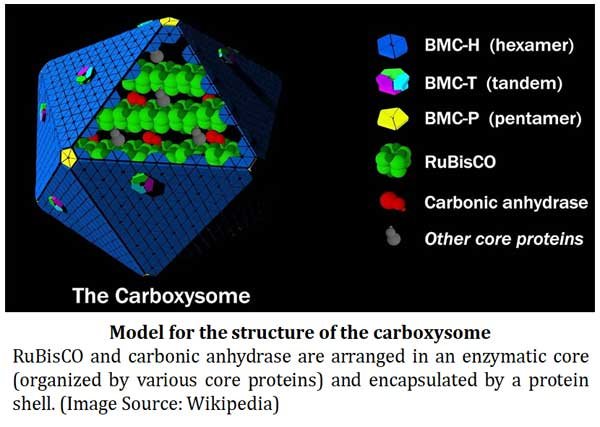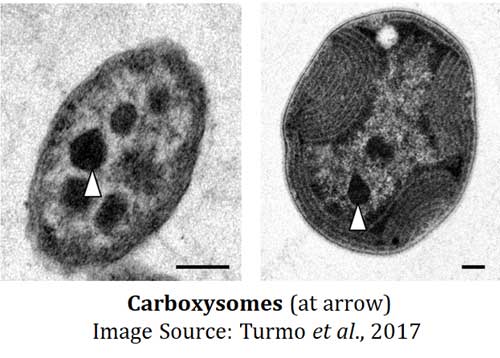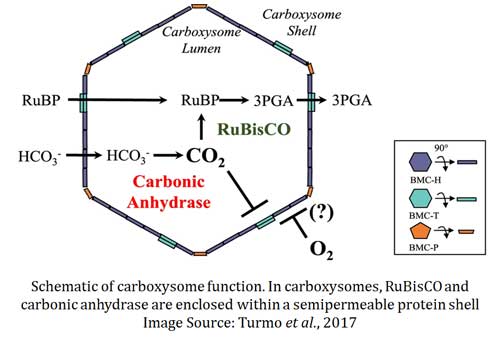Carboxysomes
Learning objectives: What are Carboxysomes? Structure and Functions of Carboxysomes. Types of Carboxysomes. Applications of Carboxysomes in Biotechnology and Synthetic Biology
In the previous post, we discussed the General Characteristics of Cyanobacteria. Cyanobacteria use the energy of sunlight to drive photosynthesis. The fixation of CO2 is a prime event in the dark reaction of photosynthesis and that is facilitated by the enzyme Ribulose-1-5-bisphosphate carboxylase/oxygenase better known as RuBisCO. RuBisCO catalyzes the carboxylation of ribulose-1,5-bisphosphate (RuBP) thereby CO2 is accepted for the synthesis of carbohydrates. The enzyme RuBisCO also has a high affinity toward molecular oxygen O2. Just imagine, you have placed one O2 and one CO2 near to RuBisCO, the enzyme will prefer to bind with the O2 rather than CO2 (in other words, RuBisCO has more affinity towards O2 than CO2).
The binding of O2 to RuBisCO causes the costly photorespiration, which ultimately decreases the efficiency of photosynthesis. To avoid photorespiration, the Cyanobacterian cells concentrate carbon dioxide near the RuBisCO enzyme so that the competitive binding of O2 with the RuBisCO can be avoided. Cyanobacterial cells achieve this through a specialized organelle-like structure called Carboxysomes. In this post, we discuss the structure and functions of Carboxysomes. We will also discuss how carboxysomes help in enhancing the photosynthetic efficiency of Cyanobacteria and also the applications of Carboxysomes in Synthetic Biology.
What are Carboxysomes?
Ø Carboxysomes are Bacterial Microcompartments (BMCs).
You may also like NOTES in...
BOTANY BIOCHEMISTRY MOL. BIOLOGY
ZOOLOGY MICROBIOLOGY BIOSTATISTICS
ECOLOGY IMMUNOLOGY BIOTECHNOLOGY
GENETICS EMBRYOLOGY PHYSIOLOGY
EVOLUTION BIOPHYSICS BIOINFORMATICS
Ø BCM (Bacterial Microcompartments): They are organelle-like structures found in bacteria and Cyanobacteria, consist of a protein shell that encloses enzymes and other proteins. BMCs are typically about 40–200 nanometers in diameter and are made entirely of proteins. The shell functions like a membrane, as it is selectively permeable. Carboxysomes are the first purified and characterized BMC.
Ø Carboxysomes are present in many cyanobacteria, nitrifying bacteria, and thiobacilli.
Ø Carboxysomes are the site of CO2 fixation in some Cyanobacteria.
Ø Carboxysomes were first purified from Thiobacillus neapolitanus in 1973, and were shown to contain RuBisCO held within a rigid outer covering.
Ø They are polyhedral protein structures with about 100 nm filled with enzymes for CO2 fixation.
Ø The main enzymes inside the carboxysomes are ribulose-1,5-bisphosphate carboxylase/oxygenase (RuBisCO) and Carbonic anhydrases.
Ø RuBisCO is the predominant enzyme in carbon fixation and the rate-limiting enzyme in the Calvin cycle.
Ø Since Cyanobacteria are aquatic organisms, they employ several strategies which are collectively known as a “CO2 concentrating mechanism” to aid in the acquisition of inorganic carbon (CO2).

Ø The best strategy used by Cyanobacteria to concentrate CO2 is by special bacterial microcompartment (BMC) called carboxysomes.
Ø Carboxysomes tether the CO2-fixing enzyme, RuBisCO, to the interior of the shell, as well as the enzyme carbonic anhydrase, using metabolic channelling to enhance the local CO2 concentrations and thus increase the efficiency of the RuBisCO enzyme.
Ø Carboxysomes are thought to have evolved as a consequence of the increase in oxygen concentration in the ancient atmosphere.
Ø This is because oxygen is a competing substrate to carbon dioxide in the RuBisCO reaction.
Ø To overcome the inefficiency of RuBisCO, carboxysomes concentrate carbon dioxide inside the shell by means of co-localized carbonic anhydrase activity.
Ø This produces carbon dioxide from the bicarbonate that diffuses into the carboxysomes from the cytoplasm.
Ø The resulting concentration of carbon dioxide near RuBisCO decreases the proportion of ribulose-1,5-bisphosphate oxygenation and thereby avoids photorespiratory reactions.
Ø The surrounding shell provides a barrier to carbon dioxide loss.
Ø This helps to increase its concentration around RuBisCO.
Ø Carboxysomes are the best-studied example of bacterial microcompartments, the term for functionally diverse organelles that are alike in having a protein shell.
Structural Organization of Carboxysomes
Ø The structure of carboxysomes were studied through Electron microscopy (Electron-cryo-tomography studies).
Ø Carboxysomes are icosahedral or quasi-icosahedral in shape.
Ø The protein components of carboxysomes can be categorized into TWO – (1). Shell Proteins and (2). Core Proteins
Shell Proteins
Ø The shell proteins form the shell of the carboxysomes.
Ø The shell consists of THREE types of protein sub-units.
o BMC-H
o BMC-T
o BMC-P
Ø BMC-H: Bacterial Microcompartment Hexamer:
o The major protein subunit of the shell of carboxysomes – has more than a few thousand subunits.
o They are organized as hexamers or pseudo-hexamers.
o There are small pores in the BMC-H protein shell which facilitate the passage of small molecules such as bicarbonate.

Ø BMC-P: Bacterial Microcompartment Pentamer:
o BMC-P occupy the vertices of the icosahedral shell.
o They are pentameric organizations.
Ø BMC-T: Bacterial Microcompartment Tandem
Ø The third building protein subunits of the shell of carboxysomes.
Ø BMC-T proteins are organized as trimers.
Ø Some BMC-T proteins aggregate face-to-face so that they form caged channel-like structures.
Ø These caged channel-like organizations have larger pore size and can regulate the opening and closing of the pores.
Ø The large pore size facilitates the passage of larger substrate (ribulose-1,5-bisphosphate) and product (3-phosphoglycerate) in and out of the shell respectively.
Core Proteins
Ø The core proteins of carboxysomes occupy inside the protein shell.
Ø These core proteins are organized as many concentric layers inside the shell.
Ø There are THREE classes of core proteins, they are:
o RuBisCO: The predominant enzyme in carbon fixation.
o Carbonic anhydrase: Enzymes that catalyse the interconversion between carbon dioxide and water.
o Other core proteins
Two Types of Carboxysomes
Ø There are two types of carboxysomes – Alpha-Carboxysomes and Beta-Carboxysomes.
Ø Both alpha- and beta-carboxysomes are similar in their appearance but differ in the protein composition of shell proteins and core proteins.
Ø They also differ in their genes for the production of core proteins.
You may also like...
NOTES QUESTION BANK COMPETITIVE EXAMS.
PPTs UNIVERSITY EXAMS DIFFERENCE BETWEEN..
MCQs PLUS ONE BIOLOGY NEWS & JOBS
MOCK TESTS PLUS TWO BIOLOGY PRACTICAL
Ø They considerably differ in their sequence of assembly pathways.
Ø Furthermore, they harbour different types of RuBisCO enzymes.
Ø Bioinformatics studies revealed that the two types of carboxysomes evolved independently.
Applications and Uses of Carboxysomes in Biotechnology and Synthetic Biology
Ø Carboxysomes have potential applications in synthetic biology.
Ø Transfer of a genetic module coding for carboxysomes has been shown to produce carboxysome-like structures in E. coli.
Ø Bioengineering of carboxysome shells have been shown feasible and carboxysomes constructed with chimeric proteins or with chimeric shells have been reported.
Ø The introduction of carboxysomes into plant chloroplasts as part of a CO2 concentrating mechanism found in cyanobacteria is predicted to have significant improvements on net CO2 fixation and yield.
References:
Ø https://en.wikipedia.org/wiki/Carboxysome
Ø https://en.wikipedia.org/wiki/Bacterial_microcompartment
Ø Aiko Turmo, C. Raul Gonzalez-Esquer, Cheryl A. Kerfeld, Carboxysomes: metabolic modules for CO2 fixation, FEMS Microbiology Letters, Volume 364, Issue 18, September 2017, fnx176, https://doi.org/10.1093/femsle/fnx176
<<< Back to Microbiology Notes Page…
If you Like this Post, I Would Like to Hear it from You… Please COMMENT . . . . (below ↓)
Learn More
@. General Characteristics of Cyanobacteria
@. General Characteristics of Algae
More Lecture Notes from Easy Biology Class…
Botany|Zoology|Biochemistry|Genetics|Cell & Molecular Biology|Biotechnology|Physiology & Endocrinology|Plant Physiology|Microbiology|Immunology|Embryology|Ecology|Evolution|Biophysics|Research Methodology|Biostatistics|Chemistry for Biologists|Physics for Biologists


